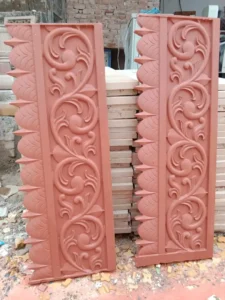Dholpur sandstone, a natural stone quarried in the Dholpur district of Rajasthan, India, is renowned for its unique properties and wide usage in construction and architectural projects. Its characteristics have made it a popular choice for centuries, especially in historic Indian architecture. Here’s an in-depth look at its properties:
What are the properties of Dholpur sandstone?
Color and Texture: Dholpur sandstone is predominantly available in a range of colors from pink, red to beige. Its fine-grained texture not only contributes to its aesthetic appeal but also provides a smooth surface finish, making it suitable for both interior and exterior applications.
Durability: One of the most significant properties of Dholpur sandstone is its durability. It can withstand extreme weather conditions, including heavy rain, scorching heat, and freezing temperatures, making it an ideal material for outdoor constructions like buildings, garden paths, and monuments.
Strength and Hardness: This sandstone is known for its considerable strength and hardness. It has a high load-bearing capacity, which makes it a preferred choice for heavy structural applications. Its resistance to abrasion and wear adds to its longevity in construction projects.
Porosity and Permeability: Dholpur sandstone has a porous structure, which allows it to absorb and release moisture. This property helps in maintaining a balance in humidity, especially in indoor environments. However, its porosity also makes it somewhat susceptible to staining, and hence, it may require sealing in certain applications.
Thermal Resistance: It exhibits good thermal resistance, which helps in maintaining a relatively stable temperature within the structures built with it. This characteristic makes it an energy-efficient building material, particularly in regions with fluctuating temperatures.
Workability: The stone is easily workable due to its softness when freshly quarried. It can be effectively cut and shaped, allowing architects and builders to use it in various designs and patterns. Its compatibility with different types of finishes, like polished, honed, or sandblasted, further enhances its versatility.
Acoustic Properties: Dholpur sandstone has decent acoustic properties, which makes it suitable for use in environments where sound insulation is desired. It can dampen noise, making it a practical choice for building walls and floors in busy areas.
Maintenance: It requires relatively low maintenance. Regular cleaning with mild detergents is usually sufficient to maintain its appearance. However, being a natural stone, it might need periodic sealing to prevent staining and water damage.
In conclusion, Dholpur sandstone, with its distinctive colors, durability, strength, and versatility, continues to be a favored material in various architectural and construction projects. Its combination of aesthetic appeal and functional properties makes it a timeless choice in the building industry.

